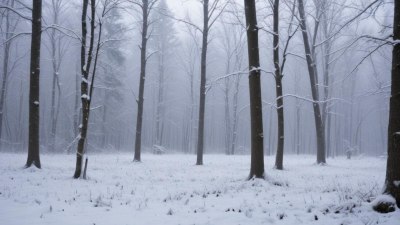The Science of Freezing Rain
Explore the phenomenon of freezing rain, its formation, and its impact on weather patterns.

Image by pvproductions on Freepik
Freezing rain is a unique weather phenomenon that occurs when rain freezes upon contact with cold surfaces, creating a layer of ice that can have significant impacts on the environment, transportation systems, and everyday life. Understanding how freezing rain forms and the conditions that lead up to this weather event is essential for meteorologists, emergency responders, and the general public alike.
By definition, freezing rain occurs when precipitation starts as snow or ice crystals in the upper atmosphere and then melts into raindrops as it falls through a layer of warmer air. If that warm layer is relatively thin and there’s a cold surface below, the raindrops can then freeze upon contact. This can lead to the formation of ice on trees, power lines, roads, and other surfaces.
The Formation of Freezing Rain
The formation of freezing rain typically depends on a few specific atmospheric conditions. It generally begins with a snow or ice crystal high up in the atmosphere. As it descends, it passes through warmer air, causing the ice crystal to melt into liquid droplets. When these droplets fall further, they encounter a thin layer of cold air near the surface, causing them to remain liquid even though the temperature is below freezing. When these supercooled droplets hit a surface, they freeze instantly, creating a hazardous layer of ice.
This entire process can seem a bit counterintuitive, as rain is usually associated with warmer temperatures. However, the phenomenon of freezing rain is most commonly observed in late fall and early winter, often associated with warm fronts, where warm moist air overrides a mass of colder air near the earth's surface.
Key Atmospheric Conditions
Several key atmospheric conditions must be present for freezing rain to occur. Firstly, the presence of a warm layer of air is crucial. This layer allows snow and ice to melt into rain droplets. The strength and depth of this warm layer can determine how much freezing rain will accumulate on the ground. If the warm layer is too shallow, the precipitation may remain frozen and fall as snow. If it is too deep, the rain may entirely lose its chance to freeze before hitting the ground, resulting in plain rain instead.
Another important factor is the temperature of the surface. When the temperature of the ground or other surfaces is below freezing, it increases the likelihood that any liquid droplets will freeze upon contact. This means that surfaces such as pavement, power lines, and tree branches can quickly become coated in a layer of ice, leading to dangerous conditions.
Regional Impacts of Freezing Rain
Freezing rain can have a wide variety of impacts depending on the region experiencing the weather event. In urban areas, it can lead to hazardous road conditions, causing accidents and significant transportation disruptions. It can also result in thousands of power outages as heavy ice accumulates on power lines, causing them to sag and potentially break.
In rural and forested areas, the accumulation of ice on trees can lead to branches breaking off, potentially causing further damage or injury. Agricultural areas may also face significant challenges, as freezing rain can damage crops or make it difficult for farmers to access fields for work.
Historical Examples and Case Studies
There have been several notable historical instances of freezing rain that have caused significant impacts. One such example is the Ice Storm of 1998, which affected parts of Canada and the northeastern United States. The storm left millions without power and caused extensive damage to infrastructure, particularly in Quebec, where ice accumulation reached up to four inches in some areas. Another example is the February 2021 winter storm that impacted large areas of Texas, leading to power outages and road accidents due to significant freezing rain.
Prediction and Monitoring
Forecasting freezing rain can be challenging for meteorologists, as it requires precise temperature readings and a thorough understanding of atmospheric conditions. Numerous tools and technologies have been developed to aid in predicting freezing rain events. Doppler radar, satellite imagery, and ground station observations are all key components for meteorologists to monitor weather patterns and make predictions about freezing rain.
One of the critical tools in predicting freezing rain is the use of computer models that simulate the atmosphere. These models can help forecasters anticipate where warm and cold air masses might interact, thus providing critical lead time for warnings and alerts. Accurate predictions can significantly reduce the impact of freezing rain by allowing people to prepare ahead of time.
Safety Precautions and Preparedness
When a freezing rain event is forecasted, it is vital to take precautions to ensure safety. Staying informed about weather forecasts and alerts is crucial, especially for communities in regions where freezing rain is common. In addition to monitoring forecasts, having an emergency preparedness plan can make a significant difference when severe weather strikes.
Individuals and families should ensure they have enough food, water, and other essential supplies on hand in case of power outages or road closures. It is also important to prepare vehicles for winter conditions, including having an emergency kit that contains necessary items such as blankets, flashlights, and a first-aid kit. Lastly, avoiding travel during freezing rain events is highly advised unless absolutely necessary, as the risk of accidents increases significantly.
Scientific Research on Freezing Rain
The study of freezing rain is an active area of research in meteorology. Scientists are continually seeking to improve our understanding of the processes behind freezing rain formation and its impacts on society. This includes studying the microphysics of ice formation, as well as the broader climatic patterns that might influence the frequency and severity of freezing rain events.
In recent years, climate change has raised questions about whether extreme weather events like freezing rain may become more common. Some studies suggest that as temperatures gradually increase, there could be shifts in precipitation patterns, which may influence the occurrence of freezing rain in certain regions. Ongoing research into these patterns will be crucial for understanding the future risks associated with freezing rain.
Freezing rain is a fascinating meteorological phenomenon that poses unique challenges and risks. From its formation to its impacts on our daily lives, understanding freezing rain is essential for reducing its adverse effects, particularly as extreme weather events become more prevalent with changing climate conditions. Continued research and effective forecasting will be critical to navigating the complexities of freezing rain in the future. As we advance our understanding of atmospheric science, we can better prepare ourselves for whatever weather may come our way.











